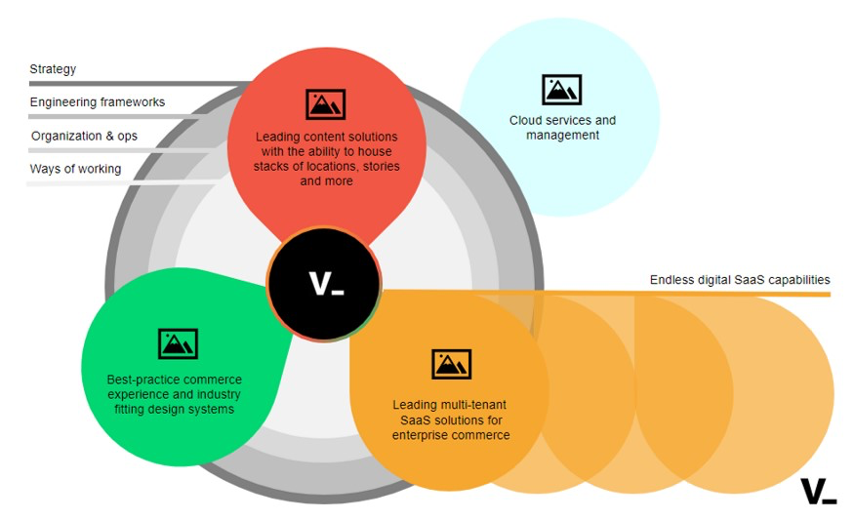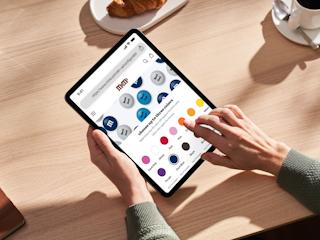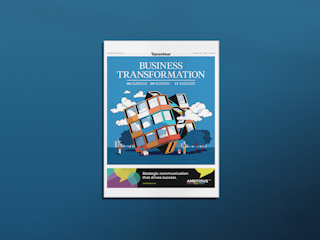“Technology” then finds a solution to fit that limited scope. Digital transformation should be a unified brand initiative – first asking the question ‘what does the future 360° digital journey experience look like for our customer?’ and only then, determining the technical solutions required to power those journeys.
In order to compete in this ever-evolving environment, marketers must become digital warriors. The technology must enable a marketer to have virtually limitless options to reach and interact with a customer - bound only by their imagination. The future state for brands that want to not only acquire customers but keep them loyal and returning, means that digital brand interactions must become experiences, hyper-personalized, lifestyle companions where commerce becomes a by-product of the relationship. Monolithic applications (which have become the norm up to now), offer businesses an all-in-one solution, geared towards a web browser interface. All too often, the business has to adapt to the monolith, and often, this limits any attempt to innovate.
Composable commerce is a solution to enable the shift in empowerment. It is also well documented that the transition to composable commerce is a large undertaking in and of itself. There is also an increased number of modern enterprises who are adopting the composable approach, and such, the bigger question is, how to scale this complexity across brands, globally.
The answer to this question is the SaaS Factory. The SaaS Factory is Valtech’s approach to enable composable commerce at-scale. With this approach, we aim to enable brand moments by activating time-to-market value, embracing change through flexible experiences, and achieving operational excellence through harnessing foundations. The desired outcome is to enable an agility driven digital framework.
Over a series of articles, we will deep dive into Valtech’s SaaS Factory concept, and showcase how Valtech has developed a solution to scale this highly complex and customized framework quickly, efficiently, and globally for business that have multiple brands under one umbrella.
The Rise of Headless Commerce
The focus of a monolithic platform was to make one “out of the box” solution that enabled the organization to have all the basic parts required to transact online. This traditional technical approach was primarily focused on the simple need to show, purchase and fulfill orders via the web. As customers became more comfortable with online shopping, brands experiencing the ‘Amazon effect’ were pushed to deliver more, faster. The result was a shift from ‘transaction’ to ‘experience.’
Fuelled by an organization’s need to provide a seamless journey across all existing digital touchpoints and to support future emerging technologies such as Virtual Reality, NFTs and the Metaverse, digital commerce has transformed to be focused on the entire digital experience. Organizations are now challenged to make complex technology look and feel seamless both in real life and through digital interactions. These heightened customer expectations have led to the adoption of headless commerce architectures.
Many technical leaders are now exploring the potential benefits of migrating to a composable commerce architecture using MACH technologies. In fact, in a survey conducted by the MACH Alliance published in March 2022, tech leaders (CIOs/CTOs, VP/SVP, Senior Manager) in the U.S., U.K. and Germany, viewed MACH as the future of commerce architecture, with 19% of companies having already started to move away from monolithic architecture and 79% of those surveyed planning to increase investment in headless over the next 12 months.
However, less than half of those same leaders were satisfied with their ability to keep up with delivering customer experience enhancements quickly. This is the key to leveraging MACH and composable commerce to ensure that your organization is prepared to pivot to keep up with the uncertainty of modern commerce and the rapidly changing expectations of consumers digital experience expectations1.
In total, over $1.65 billion in funding has been raised for headless technologies over the last two years. Even legacy platform provider Salesforce agreed to buy headless CMS company Mobify for $60 million2.
Why Composable?
The Composable best-of-breed (or best-for-you) approach is the opposite of the monolithic technology architecture that many of us are more familiar with, where there is one single enterprise vendor running multiple aspects of your digital ecosystem.
‘Composable’ is the term used to describe a technology stack that is composed of multiple technical (often cloud-native) solutions, all working in concert with each other, to enable a more nimble, flexible and responsive architecture.
Think of Composable Commerce as like a collection of Lego bricks; each brick represents a digital ability that is core to its digital business, which the company can put together and re-configure in different ways. The company can thus select the bricks they want to use to build exactly the type of digital solution needed for a particular channel and purpose. Casper Rasmussen, SVP Global Technology, Valtech
Read more from Casper in this article - featured in The Times - on why becoming a digital enterprise might be painful, but it's non-negotiable.
The technologies involved in a composable architecture are commonly referred to as MACH technologies.
These are a set of architectural principles that offer a high level of control and agility. But, to understand how that works requires a deeper understanding of each element.
Microservices: Single pieces of functionality that can be individually designed / deployed, leading to faster development and release cycles and quicker updates.
API-driven: Enabling the flow of data between microservices and acting as the ‘glue’ to link it all together.
Cloud-Native: For on demand access and unrivalled scalability. Making it easy to expand your reach across regions and channels and provide a better customer experience.
Headless: The ability to deliver amazing front-end experiences without getting distracted by the back-end architectures. Freeing you up to respond rapidly to changing market conditions.
Each factor in a composable enterprise architecture is designed to make it quick and easy to change and update your platform on the fly (as well as many other benefits), but it’s this quick adjustment ability that allows brands to be more agile and to make changes without having to wait for major updates to their suite solutions. This quick-change ability is what makes businesses that include MACH principles into their digital platforms future-proof.
The Paradigm Shift
Just like all new technologies and new ways of thinking, at present, there is a small but growing number of leaders, business users and engineers with practical hands-on experience of how to enable this new way of commerce. The transition towards composable commerce requires people to be both strategic and tactical, to ensure the digital transformation goals are implemented properly and with limited to no impacts on daily business. To enable an organization requires a massive paradigm shift on multiple fronts.
Vendor selection is the most apparent shift from your traditional way of operating. During the monolith era, it was not uncommon to deal with only one vendor but due to the nature of composable, interacting with multiple vendors is the norm. Before selecting a list of vendors to drive the digital transformation, a thorough definition of the business needs is critical.
The requirement gathering process must include input from all teams impacted within the organization. A single person should be responsible for orchestrating the requirement gathering across the organization through internal research, interviews, meetings, and demos. From there on, the vendor selection process should be facilitated, and the leadership approval expedited.
Vendors should not be considered on capability alone. While technical and functional requirements are critical, quality and availability of their support system, business user interface ease of use, system integration partners program and even whether their culture matches with the organizations to make for a smoother roll-out and future enhancement partnership, are key to success.
“Gluing” the different vendors’ solutions is the next big shift. Typically, a solution should focus on one business domain, and the different domains should be integrated to offer a seamless experience for the end user. Note: Having multiple vendors to manage may require a new position to be created within the organization that has both procurement and technical knowledge.
Transitioning a large organization to this new technical architecture requires not only a very specific skillset but also creates an entire paradigm shift in governance and ways of working across all departments. When previously releases were happening in multi-weeks long sprints, composable enables releases at a faster frequency. This creates a completely new cadence of feature and functionality prioritization within the organization.
The traits that make composable so flexible and desirable can also create significant pitfalls if the entire stack and the future business goals and digital requirements to capture those goals are not considered in the long-term plan. Before starting a composable transformation the return on investment must be considered. Breaking apart a monolith can sometimes translate into savings, but it can also add cost due to SaaS fee structures, cloud expenses and additional headcount or training existing employees.
The factory model represents a significant cost saving for organizations that operate multiple brands not just by reducing total cost of ownership over time but also through the benefits composable provides by delivering more value to the business, more quickly.

The Next Generation of Composable
The world is changing at a massive pace, and at no other time has it been more important to transform your digital operations. Companies cannot afford to stagnate; they must implement forward-looking strategies to harness technology for acceleration or risk losing touch with their customers. The headless revolution has arrived and will soon be infiltrating all of your digital channels and delivering on the total enterprise experience. Businesses must focus on real value generation - at scale - leveraged by composable solutions.
We are now able to unlock enterprise bimodal capabilities, micro frontends, digitalisation, experience architectures and commerce everywhere via the power of composable as a whole. These solutions require a different mindset, one with flexibility at its core, and one that is comfortable working in the distributed cloud. End-users have begun to expect a personalized, seamless omni-channel experience within milliseconds on every device and in every online transaction. Forward-thinking companies will ditch outdated platforms for headless tech stacks that allow them to select best of breed technologies for each layer in the stack. This composable approach provides businesses the ability to innovate quickly based on metrics and customer feedback, be flexible as changes are required due to logistics challenges and provide a future-proof, scalable platform.
Read more: about what it takes be be a future-ready business in this piece from Mihaela Mazzenga, North American CTO, Valtech.
Global organizations, many of which typically have multiple brands under one umbrella, often have multiple tech stacks that vary by brand or region. This of course adds an additional layer of complexity. But, it is possible to take this complex stack and create a foundation. A well architected composable foundation strategy can set a multi-brand organization up for quicker time to market in transitioning other brands while also enabling unique SaaS tools to each marketing team while also lower total cost of ownership.
The SaaS factory can help streamline tangled legacy stacks, leverage more from existing vendor product offerings, and break down silos resulting in more technical efficiency across the entire suite of brands within an organization while enabling business users with the tools they need to create unforgettable experiences.
In the second article in this series, we take a deep dive into headless and composable commerce architecture. We will explore the details of the technical architecture as well as how the business users should start to realign their governance and process to take full advantage of the digital transformation. Building that foundation will be key to setting up technical and business requirements to unlock and enable the SaaS factory.
About the Authors
Karen Light, Director of Digital Strategy, Valtech North America
Karen has 20+ years of experience in DTC and B2B retail leadership positions in a variety of roles including merchandising, product development, ecommerce and most recently spearheading the composable digital transformation strategy at SmileDirectClub. She has a strong focus on the digital customer experience and innovation, known for pushing the boundaries of “what if” that can be translated into a strategic plan based on data and value to the business.
Jerome Chan, Director of Ecommerce, Valtech North America
Jerome has 15+ years of experience in the commerce space with an in-depth understanding of the technical needs and challenges to successfully bring a project live. His focus was primarily driven by monolith applications when a few years ago, the attention shifted to a composable mindset. He thrives in collaborating with multiple stakeholders, leveraging his technical experience, and providing strategic approaches for any endeavors, big and small.
References:




